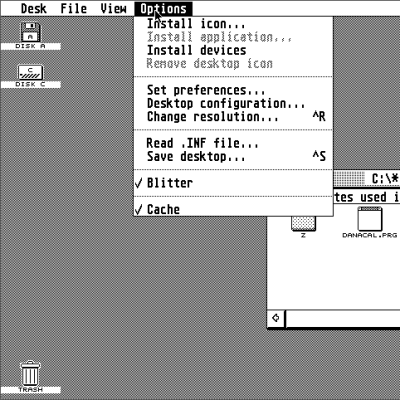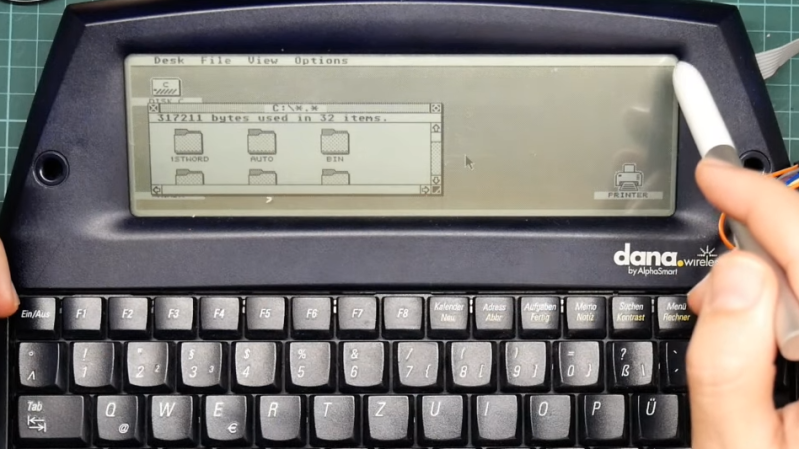Get ready for vintage computing aplenty in [David Given]’s project to port EmuTOS to the AlphaSmart Dana. He’s got it all on video, too. All 38 hours of it over 13 episodes!

[David]’s fork of EmuTOS is an open source version of the Atari TOS, which is itself the 68000-based OS for the Atari ST line of computers.
As for the AlphaSmart Dana, it is a roughly twenty-year-old portable word processor thing with pen input which runs a version of PalmOS. It’s a slightly oddball piece of hardware, but quite capable in its own way. A match obviously made in heaven? It is if you have [David]’s skill and drive!
To get EmuTOS working on the Dana, the first step was figuring out how to find and work with the Dana’s debug port, using it to get direct access to the CPU while bypassing the boot ROM. Turns out that the Dana’s 68000-compatible processor has a handy feature: by manipulating the right pin, one can remote-control the CPU (to a certain extent) via the UARTs. That’s the entry point for a whole lot of hacking that ultimately results in firing up the GEM desktop on the Dana, and being able to run (some) original Atari ST software. Probably the biggest issue is that the screen size isn’t a great match for what the OS expects, but it works.
[David] really knows his stuff and has a real knack for working with vintage hardware, and within its limitations. For example, we were blown away when he showed how a first-person perspective 3D game was possible on the Commodore PET, despite being limited to a character-only display and only 32 kB of memory.
Embedded just below the page break you can watch the whole process (a 13-video series that begins with figuring out how to access the debug port) of porting EmuTOS to the AlphaSmart Dana, or you can jump straight to seeing the GEM desktop running happily.
















Next up – port of AROS? :-D
Then you could run AmigaOS programs on that thing!
Oh it occured to me – many/most Amiga programs use the hardware chipset in some way, and would not work even if AROS was ported to this Dana thing.
But you know what computer hardware is much more similar to this Dana?
The Mac! The ones with black and white screens.
If you got AROS ported and the ran this Mac emulator
http://basilisk.cebix.net/
this Dana would be a very fast, portable Mac. :-D
AROS is much more complex. EmuTOS will run on pretty much anything with a simple framebuffer and an interrupt system, which was why I picked it. AROS would make a nice project, though, if I could find any documentation at all…
Regarding running Mac software: the biggest problem is that the 200-pixel-high screen isn’t big enough. The smallest Mac screen was 512×342. Also, why emulate the 68000 when you’re already running on one? All you’d need to do is to completely rewrite the Mac ROM…
AROS is much more complex, but the driver stack is not. It’s just as easy to port as EmuTOS is. Also Basilisk is not emulating the 68000. It runs as a process inside the Amiga, at full speed. In fact, for a hot minute, An Amiga with 68060 accelerator was the fast Mac for Photoshop! :-D
(Until Photoshop got PPC plugin support.)
Always an Amiga owner droning on…🙄
There’s a small amount of stuff that doesn’t need the Amiga custom chips. Mostly desktop stuff AFAICR like sokoban and minesweeper type games. Amiga “clones” were known of, which used PC graphics chipsets for 3D work, so looking at the non-“power user” type apps that could run on those, might turn up a list, i.e. “What amiga software runs on Draco clone?” and ignore graphics stuff.
I had one of these as a school kid.. I miss it. It’s great to see something like this being done. Hopefully some day I can get my hands on a other one for such nostalgia :-D
The various AlphaSmart devices are still fairly in-demand on the used market because novel writers like the distraction free environment. The Dana is less popular as the battery life is worse due to the higher overhead palmos environment, but plenty of others still love these devices.
I sold one a few years ago with adb and ps2 ports. Kind of a nifty device when laptops were expensive and short battery life. You could just take one to the beach and work on your novel.. These just ran on AA batteries and emulated a keyboard. I just picked up one the other day with a USB port, but gave had a chance to do anything with it yet
AlphaSmart copied everything about the Tandy Model 100/102–except the wonderful Alps keyboard. Sigh.
The Dana keyboard is pretty much the same as the one for the AlphaSmart 2000 and 3000, and isn’t spectacular, but the keyboard on the original AlphaSmart and the AlphaSmart Pro — the beige boxy ones from before everything had to look like an iMac — was quite nice, I thought. (I’ve got a stack of the keyboards somewhere; I think it was Alltronics that was selling the surplus stock.)
I’ve been intending for years to turn an AlphaSmart Pro into a cyberdeck by turning it into a serial terminal and attaching that to an internally mounted Raspberry Pi, but other projects keep having priority.
Small nitpick: the Dana keyboard (and for that matter, that of the Neo and Neo 2) is leagues better than the 2000 and 3000 models. It uses scissor switches, more similar to non-chiclet laptop keyboards. Typing on the 2000/3000 is a chore by comparison.
Wow, David worked WAAAAY too hard to do this. Special pin to control processor? PalmOS doesn’t stop you from just taking over…this could be done without opening the case.
Ahh, CP/M 68k. Sweet memories.